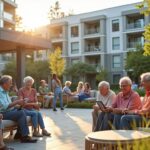Senior living facilities offer a welcoming space where older adults can enjoy appropriate care, social connections, and a fulfilling daily routine. These communities often provide multiple levels of support for a wide range of lifestyles, allowing residents to thrive at whatever stage of aging they experience. Many older adults appreciate a living arrangement that offers a balance of independence and assistance, and that is precisely what well-designed communities aim to deliver. Rather than navigating the challenges of aging on one’s own, many seniors find a renewed sense of belonging in these specialized settings, which can cater to various health needs and personal preferences.
Contents
Creating a Welcoming Environment
When people think about a new living arrangement, comfort is one of the first considerations. Many senior housing options have redesigned their layouts to include cozy common areas and private living quarters that feel like home. Maintaining familiar routines can help individuals settle smoothly into a different space. Personalizing rooms with cherished furnishings and photographs also helps build an immediate feeling of familiarity.
Another crucial aspect that promotes a warm environment is the staff’s approach to daily support. Trained team members often encourage residents to pursue hobbies, engage in group activities, and explore the outdoors in safe, supervised ways. This level of attentive care promotes both independence and community engagement. Kind smiles, friendly greetings, and a willingness to listen can profoundly shape how residents adapt to their new surroundings.
Embracing Independent Living Options
For those who want to maintain their autonomy, independent living embodies a blend of privacy and convenience. Residents can have their own apartments or cottages while still enjoying the advantages of on-site amenities. Things like fitness centers, dining rooms, social clubs, and cultural programs help individuals stay active. Alongside these offerings, there’s no pressure to keep up with household chores, thanks to services like laundry and housekeeping.
Some independent living setups sit within larger retirement communities. This structure means that if someone ever needs additional help, they don’t have to move far. People can move into more supported living arrangements in the same community. This ease of transition is often seen in continuing care retirement communities, where independent living, assisted living, and skilled nursing facilities are part of a broader campus.
The Benefits of Assisted Living
When aging adults require help with tasks like dressing, bathing, or managing medication, assisted living becomes an appealing option. Trained caregivers ensure that residents follow their prescribed health routines. They also provide emotional support, companionship, and assistance with daily activities. Many assisted living communities integrate senior care services like therapy sessions, specialized dining plans, and organized social activities for seniors to keep residents engaged.
Balancing supervision and personal choice is a hallmark of a good assisted living setting. While there’s someone on hand to help if needed, residents still have the freedom to shape their schedules. This arrangement often leads to a sense of dignity and empowerment. Most communities encourage group gatherings to combat loneliness and to nurture friendships among residents with shared interests. Because of the supportive environment, many older adults find that assisted living reduces stress and boosts their mood.
Memory Care and Specialized Programs
Memory care is designed for seniors coping with cognitive challenges, such as dementia or Alzheimer’s. The environment caters to these residents through secure layouts and staff trained to meet unique cognitive needs. For example, life enrichment programs often include puzzles, music sessions, and art therapy, which help stimulate the mind in gentle, reassuring ways.
Safety measures also play a significant role in memory care facilities. Hallways might have clear signage and color-coded prompts to guide residents. Staff members frequently provide reminders about mealtimes, appointment schedules, or group projects. Family members find peace of mind knowing their loved ones are in a place that can manage potential disorientation or wandering while still preserving dignity and autonomy. This combination of structure and empathy makes memory care an invaluable resource for individuals who need more focused support.
Enhancing Quality of Life Through Social Activities for Seniors
Staying active and socially connected is often at the heart of a positive lifestyle for older adults. Whether through daily exercise groups, book clubs, volunteer programs, or day trips, these social opportunities significantly boost mental and emotional health. In many retirement communities, a dedicated team coordinates activities designed to spark interest and promote interaction. Some might enjoy gardening or craft projects, while others prefer dance lessons or group outings to local museums.
Building friendships in senior living facilities can ease feelings of isolation. It’s not just about passing time but discovering new passions and reigniting old ones. Indoor or outdoor spaces that support physical activity—like walking tracks and game rooms—contribute to a sense of camaraderie. By offering a range of social engagements, communities empower residents to shape their daily routines based on personal interests and energy levels.
Active Adult Communities for Vibrant Living
Active adult communities cater to individuals typically 55 and older who are healthy enough to enjoy a wide range of recreational pursuits. These communities often feature amenities such as swimming pools, hiking trails, tennis courts, and fitness classes. The goal is to create a vibrant atmosphere where each resident is encouraged to explore new activities and maintain an energetic, healthy lifestyle.
In such settings, neighbors with similar life experiences naturally connect, sharing hobbies and forging friendships. The emphasis here is on independence, yet there is also a schedule of optional events. Some might be themed around holidays, while others center on sports competitions or music recitals. This blend of freedom and organized fun is a key part of what makes an active adult community feel so dynamic.
Maximizing Health and Wellness
A commitment to health and wellness programs underscores many providers’ dedication to holistic living. A variety of on-site resources helps seniors keep their wellness in check. This can include easy access to healthcare professionals, therapy sessions, and nutritional counseling. Group exercise classes such as yoga or low-impact aerobics also provide a structured approach to staying active.
Good nutrition is central to a balanced life, especially for older adults who need to maintain strength. Many assisted living and independent living communities integrate chef-prepared menus that account for dietary restrictions or chronic conditions. This thoughtful approach often points to improved overall wellbeing, as it ensures that residents are getting the nourishment they require.
Skilled Nursing and Rehabilitation Services
Sometimes, individuals need short-term or extended medical attention after surgery or during an illness. Skilled nursing departments have trained professionals on hand to deliver personalized rehabilitation services. This can include occupational therapy to help regain essential daily skills, physical therapy to improve mobility, and speech therapy for communication challenges.
In certain senior living facilities, skilled nursing forms part of a continuum of care, ensuring that even the highest level of support can be found in the same community. That sense of continuity reduces disruptions for residents who prefer to stay where they already feel comfortable. It also relieves family members, who don’t need to search for a new facility in case of heightened health concerns.
Home Health Care for Aging in Place
Some communities recognize that aging in place is vital for many older adults. For this reason, they offer home health care services so residents can remain in their familiar apartments or cottages. Nurses or therapists visit regularly to check vitals, manage wound care, or provide personal care homes services such as medication reminders. This approach maintains a sense of independence while offering the security that help is near.
Delivering consistent, personalized care at home is especially beneficial for individuals with mobility challenges. They still partake in social opportunities and community dining, but they don’t have to worry about traveling for routine medical check-ups. Over time, this approach can help residents feel more at ease knowing that trusted caregivers are just a phone call away.
Prioritizing Safety Features for Seniors
Many senior living facilities focus on designing spaces that reduce the risk of accidents. Non-slip flooring, handrails in hallways, and grab bars in bathrooms can make everyday movements safer. For seniors with decreased mobility or conditions like arthritis, proper lighting and clear signage become crucial. These measures encourage residents to move about with confidence.
Respite care programs also often rely on these safety features. When families or primary caregivers need a break, they look for a reliable setting that provides a secure, nurturing environment. The presence of on-site medical staff, assisted bathing services, and emergency call systems helps ensure that short-term stays are both safe and comfortable. Such strategies emphasize prevention, but they are also designed to respond quickly if an urgent situation does arise.
Advantages of Affordable Senior Housing
The notion that all senior living options are expensive can deter families from exploring opportunities. In reality, there are affordable senior housing communities that work within budgets while maintaining solid services and enjoyable amenities. Some are funded in part by local programs, while others have top-tier organization that helps minimize unnecessary costs. Residents often find that these places still provide essential offerings, like group dining and light housekeeping.
Senior apartments, for instance, can be cost-effective, independent living spaces. Rent can sometimes be subsidized based on income or needs. Although the scope of services might be more limited than in a high-end setting, essential care for seniors remains a priority. Because of the supportive community atmosphere, people don’t feel left out or neglected. Instead, they benefit from social engagement and vital resources while living at a manageable price.
Creating Personalized Comfort
Even with the variety of options available, personalization remains key. Whether someone chooses adult care homes, nursing homes, or more independent layouts, the best arrangement centers on individual needs. Some people need round-the-clock support, while others simply need well-structured social gatherings and minimal intervention. Finding the right balance contributes to emotional well-being and fosters a sense of dignity.
Plenty of elder care facilities actively encourage families to visit or even participate in planned events. Continuous communication with staff ensures any changes in health are promptly addressed. By tailoring care plans to each resident, communities can fine-tune medication management, fitness options, and group activities. Ultimately, what truly matters is that each resident feels valued and has the freedom to live life with a sense of purpose and enjoyment.
When older adults find a living arrangement that matches their physical, emotional, and social needs, they often rediscover a sense of vitality. Senior living facilities frequently move beyond mere accommodations to create tight-knit spaces where residents can explore hobbies, build new friendships, and access healthcare resources in one location. With the right balance of independence, care, and human connection, these environments can provide a fulfilling lifestyle for aging individuals searching for comfort and community.




